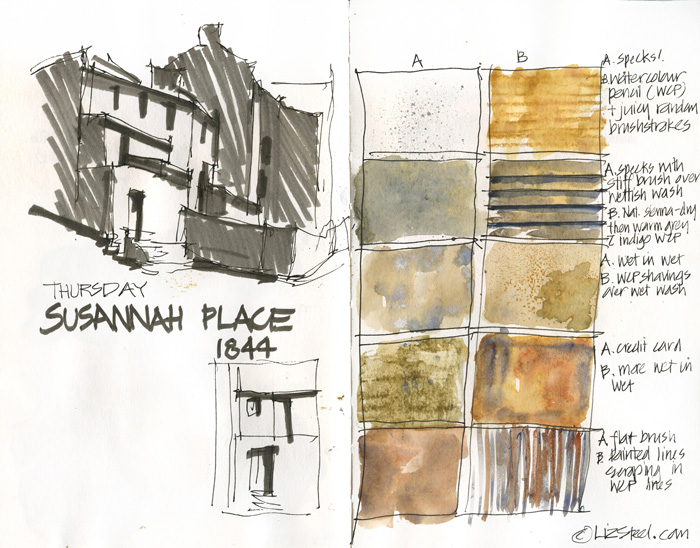
How to sketch texture is a question that comes up often when I ask people what they struggle with sketching architecture. And so it is not surprising that I received a question about it this week in my online class Buildings. Because it is a little off topic in the course (this week), and because I have shared these pages before publicly on my blog, I thought I would write a few comments about some fun ways to achieve texture with watercolour.
I rarely include much texture in ink when I am sketching buildings, mainly because it is normally less important to me than the design of the building. Yes, sure it might be a brick building, but I am often more interested in the shape of its volumes or a specific architectural detail. Also drawing texture in ink can become tedious and often have to commit to drawing many more lines than I would like. There are ways at hinting at texture with ink (by picking up the dominant pattern of the texture) but it is much quicker and easier to express the sense of a texture in paint.
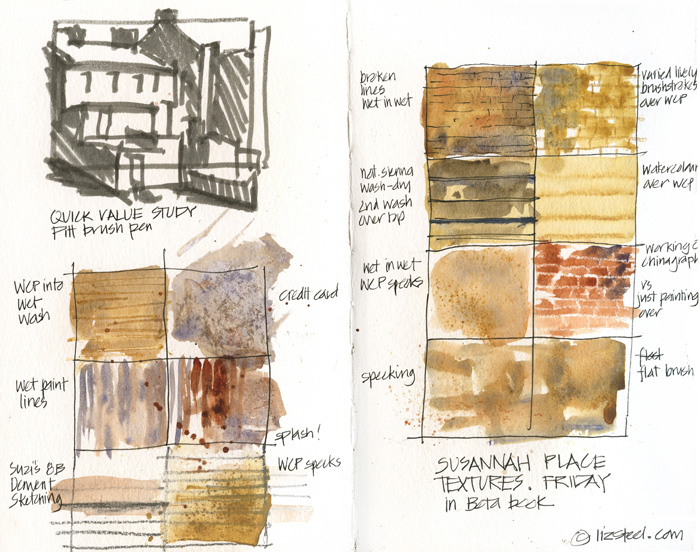
So these pages, which were originally done as demonstrations at two face-to-face sketching classes, show a number of different ways of achieving some texture with paint and a little pencil.
The important questions to ask yourself are how dominant is the texture when you squint, how important is it to the story you want to tell in your sketch. If it isn’t that important, don’t get distracted by it!
In the last two lessons of the Buildings course (registration closes tomorrow!) we will be looking at working structurally and mapping light and dark. In both of these lessons, texture will be considered as the very last step. It’s not that I don’t think its important, it’s just that we have a natural tendency to over emphasis it, so by leaving it to last we can be more in control of what we want to say about it, in a way that won’t take away from the rest of the sketch.
Anyway, these are a few ideas on texture to get you going.
What are your struggles when it comes to adding texture to your architecture sketches?
SketchingNow Buildings is now available as a self-directed course with lifetime access.




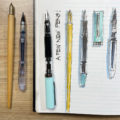
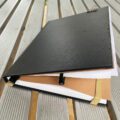
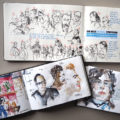
12 Comments
Thanks Liz! This is a nice complement to the class. I think I may have used too much ink on the North Sydney cottage for texture. I will certainly save this info for future reference. I’ve yet to do my outdoor exercise and with predictions of 100F for the next few days may not get it done until the Review Week.
How do you achieve the wcp specs? Sharpening leavings?
Super feedback and thanks for the bonus on texture. Appreciate all your hard work in developing these lessons and getting us out of our comfort zone (at least for me). Progress is being made!
Really helpful this extra information of texture. Thanks for the tremendous effort.
I’m always struggling to use just the necesssary texture in architecture. I get lost in unnecessary details but I believe I’m improving with the lessons
With texture, my main problem is scale: if I get to interested in texture ( or detail on a building, for example), I tend to draw it too large and out of scale, or I get carried away and do too much of it, losing the underlying form. But then restraint isn’t my strong point, ever !
I am so glad to be learning this about texture. I couldn’t quite identify what my problem with sketching bricks on the walls until Suhita named it, “Scale”. Wow, that is so me too. My bricks are giant when I think of it in proportion to the rest of what I am trying to draw on a building. Thanks Suhita! And thanks to you Liz for this post. I may never draw another brick – thanks for the permission. I love the ideas above instead. I am really loving this course. Thanks so much Liz for all your teaching.
Hi Liz. My problem with texture is I tend to draw ‘ every brick’ and in ink! I have just started trying the wcp method but with a gentle hand and without doing every line. These are all great suggestions and I’m going to give a few of them a try. Thanks, Liz.
What is “working chinagraph”, please? It looks spectacular, but it also looks like painting every brick.
Hi Deborah,
I had to look that one up on Wikipedia – hope the quote below helps! Looks like the bricks were drawn w the pencil and then painted over w watercolour. 🙂
“The grease pencil, a wax writing tool also known as a wax pencil, china marker or chinagraph pencil (especially in the United Kingdom), is a writing implement made of hardened colored wax and is useful for marking on hard, glossy non-porous surfaces such as porcelain, glass, rock, polished stone, plastic, ceramics and other glazed, lacquered or polished surfaces”
Oh, that makes perfect sense! Thanks, Emma.
HI LIZ
Just received your book \What a little gem////
Congratulations and best wishes
Dale Curry
retired ex arch. drafo Adelaide
Hi just wondering how did you do the texture A using a credit card? Its really pretty
NEWSLETTER
Subscribe for first notification of workshop + online classes and more.